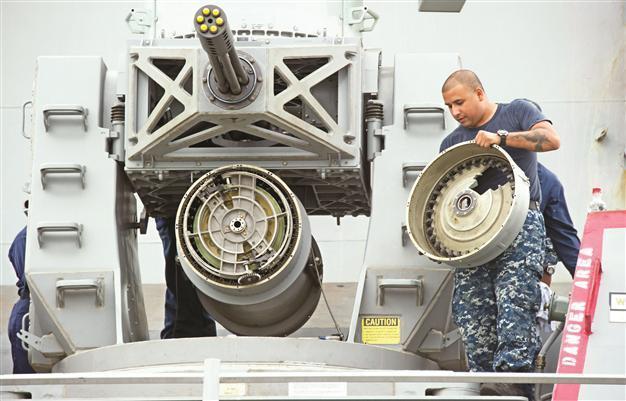US raises Navy investment against Iran, North Korea threats
NORFOLK - The Associated Press

A sailor conducts maintenance on a weapon system aboard the missile destroyer USS Stout. The ballistic missile destroyers are in hot demand by commanders across the Mideast, Europe and the Pacific. AFP photo
The United States, in response to advances in missile threats from Iran and North Korea in recent years, is making greater investments in Navy cruisers and destroyers that carry a high-tech radar system and dozens of missile interceptors.As a result, the ballistic missile defense destroyers and cruisers that carry the high-tech Aegis system are a growing capability that is in hot demand by military commanders across the Middle East, Europe and the Pacific.
“They give the capability to the combatant commanders that allows them to position [the ships] where there’s a need, and we feel they’re a pretty good investment,” said Adm. Bill Gortney, commander of U.S. Fleet Forces in Norfolk. Unlike other missile defense systems, he said the ships are “able to sail to where the crisis is.”
Anthony Cordesman, a national security expert at the Center for Strategic and International Studies in Washington, said the ships provided a layered defense that could quickly provide warning and details of a missile launch in areas of the world where there may be only a limited time to mount a response. And they present an added complication and deterrent for an adversary such as North Korea or Iran that may be trying to target a nearby U.S. ally – such as South Korea or Israel.
‘A costly weapon’
At the same time, however, he said the missile defense ships with their constantly improving sensors, radars and missiles had become a critical yet costly weapon.
“This is going to be an evolving technology duel,” Cordesman said. “We will see steadily better missiles, warheads and countermeasures, and that means that ships will have to be upgraded.” But he added that those things are considerably easier to upgrade than the military’s pricey aircraft.
Still, the increasing requirements for the ships also exact another toll on the already-strained naval forces. Commanders are routinely forced to extend the ships’ deployments, keeping sailors at sea for longer periods and shrinking their time at home.
In all, the Navy has 28 ballistic missile defense ships – 16 are based in the Pacific and 12 in the Atlantic. That number is expected to grow to 30 by the end of 2018, with funding for several more in the pipeline in the years ahead. The average cost to upgrade the ships with the new Lockheed Martin Aegis radar system and the Raytheon SM-3 missiles is roughly $45 million.
The ships serve as both defensive and offensive weapons. The SM-3 missiles can zero in on and take out short- to medium-range missiles that might be fired at U.S. or allied forces, and they also carry Tomahawk cruise missiles that can be launched from sea and hit high-value targets or enemy weapons systems from afar, without risking pilots or aircraft. That dual mission is particularly key now, as the ships in the eastern Mediterranean keep watch on Iran for any possible missile launches but also are ready if the U.S. decides it needs to take action against Syria. Much like during the 2011 operation in Libya, missiles launched from Navy ships could take out Syrian air defense systems without putting U.S. troops at risk in a ground assault or sending fighter jets into Syrian airspace.
















